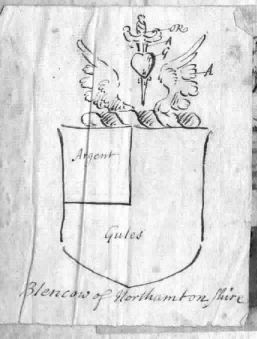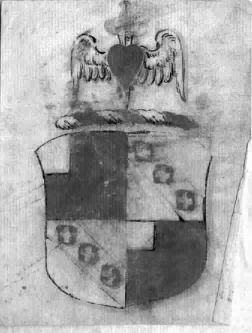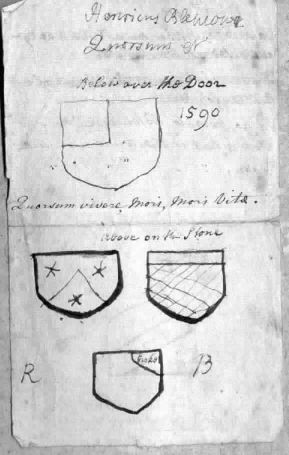‘The life of Christopher Blencowe’: a seventeenth century manuscript re-discovered!
The cover illustration is part of the fly-leaf of a small booklet that reached me in a most interesting way. At the end of April I received a letter from Peter Roden who lives in Bradford:

I am prompted to write to you by the review of your book in the current edition of the Journal of One-Name Studies which I received this week. About 40 years ago, whilst I was an undergraduate at Cambridge University, I saw an old book on a stall in the Market Place there with the following title page:
The Life of Christopher Blencowe, of Blencowe, Esqre [1598-1669]
The book measures 6 x 7½ ins, contains 44 hand written pages, and one of the notes in it is dated June 7th 1740. I bought it from the market trader simply because it was ‘old’, and it seemed like a good idea at the time to ‘rescue it from oblivion’.
I have no idea what I paid the market trader for the book originally, nor any idea of what its current market value might be, nor any intention of seeking commercial gain from the original investment. But it does seem to me that the book was compiled for, and intended to be a family heirloom, for the Blencowe family. How it got to the market stall in Cambridge 40 years ago, I have no idea.
If you would like to have it, I would be happy to pass it on to you’ and to keep unquantified commercial aspects out of the transfer, perhaps a ‘swop’ for a copy of your recent book on The Blencowe Families might be appropriate?
Interested?’
Of course, I jumped at the offer and soon received the little book, together with a full transcription that Peter had made some 40 years ago. It has slightly tattered red hard covers; the main text is written in ‘secretary hand’ and probably dates from before the death of Christopher’s widow Mary in 1674. The writer of the extensive notes dated 1740, mentions ‘my brother H.B.’ who visited Oxford in 1736. This would have been Henry Blencowe (1712-1765) who married Mary Prescott of Thoby Priory in Essex, the grand-daughter of Sir John Blencowe of Marston St Lawrence -- the marriage that re-united the northern and southern branches of the family. The writer was probably Henry’s younger brother William (1714-1769) who married Elizabeth Latus (Layton?) and through her inherited Lowick Hall in Lancashire. For convenience I will refer to William as the writer of the notes from here on.

It appears that Christopher Blencowe had written a collection of religious ‘Meditations’ that his widow wished to be published, and she had asked Rev. Gabriel Smallwood, Vicar of Appleby, to write a preface for the book; Gabriel was son of Rev Dr Alan Smallwood, Rector of Greystoke 1663-1686, and I imagine that he must have based his account on his father’s reminiscences.
Our book is the text of the preface; we have not seen any record of the ‘Meditations’ having been published, but William wrote, " This book of Meditations is still remaining in the hands of Mr Tenant of Chapel House in Craven, Yorkshire, whose Mother was one of the said Mr Blencowe’s Daughters..."
Smallwood sets out to rebut unjust remarks made about Christopher at the time of his death but draws a picture of a rather strange man and, if anything, damns him with faint praise.
Christopher was born in 1598, third son of Sir Henry Blencowe. After a spell at Magdalen Hall, Oxford he studied civil law at Grey’s Inn in London and was called to the Bar. Smallwood describes him as ‘of a Pregnant & industrious Disposition’. The other sons pleased Sir Henry less: William includes a copy of a letter from Sir Henry to his eldest son John in London in which he complains, "For thy Brother Anthony I can say no more than I have written, only this much, I utterly mislike his idle carriage since his coming thither".
Back in Blencowe, Christopher is described as of ‘Swarthy Visage and Ebon Hair’ (that had since turned white); ‘it must be confessed that he was neither of a gracefull Countenance nor winning Presence ... As to his Stature, He was of the lower Sort, & of a spare & weakish Body. [he] Delighted not in boistrous Altercations, ...but in solitudes & Private Retirements, ... He Delighted more in his Study than in his Dining Room ... He was of that Frugality that he would never be guilty of the least vain Expence’.
He spent so much time at his studies that it was said ‘that he knew not his own Cattell’. He ‘used no Recreation but only to walk sometimes in his Garden or Oarchard ... Which Innocent Divertisement malevolent Tongues Misinterpreted as done to the Preservation of his Apples.’ Dismissing this allegation, Smallwood recounts that ‘once espying a Youth in the Top of one of his Trees, & bidding him to come Down, the Malepert Boy replied that he wou‘d there hang himself upon one of the Bows unless he wou‘d Promise to let him go without Punishment. Whereupon the good old Gentleman ... freely Dismist him with Pardon & Impunity.’

Smallwood continues at considerable length to excuse Christopher of the local accusations of miserliness. However, after his death on 23 April 1669 the Inventory of his Goods & Chattells (taken on 13 May) reported £1,544 in gold and money and £286. 19s. 0d. of debts owed to him. In his Will he had made charitable bequests of £20 and left 5 shillings to each of his servants, in the circumstances this cannot be regarded as munificent!
Smallwood does make one lighter comment. His father had told him that, on the last time Christopher had taken Communion he ‘Invited the old Gentleman when the Sacrament was adminstred, & the Service ended, to Partake of the consecrated Wine that remained, which he cheerfully accepted’. Two weeks later he died ‘Suddenly in the Field by a Fall from his Horse’.
The history of the book remains a mystery. I would guess that William took the ‘core’ manuscript by Smallwood and added notes at or about the time that his brother‘s marriage to Mary Prescott was being arranged. It looks as if he was researching the family history at the time of the reunion of the two branches of the family. The coat of arms on the flyleaf, beautifully executed in pen and coloured inks, shows the union of the arms borne by the southern branch with those of the Cumbrian family. There are several other sketches of coats of arms pasted inside the covers, including one labelled ‘Blencow of Northamptonshire’ and another that appears to be a drawing of the Blencowe arms still displayed in the church at Marston. The colours of the latter had ‘run’ and a note on the back reads, ‘ This was spoiled by throwing water upon It, as it being up in a Room when a Fire happened.’!
However did it find its way to Cambridge Market? To add to the puzzle, Peter Blencowe has another transcript of some or all of the text written in a quite different, 19th century hand!
I am making a facsimile of the original and will face the images page-by-page with a fair copy of Peter Roden’s transciption. As we already have transcripts of Christopher’s will, the inventory of his possessions, and even the cost accounts of his funeral, it could make an interesting little book. I will get an estimate of cost and we can decide whether it is of sufficient interest for the Association to publish it.